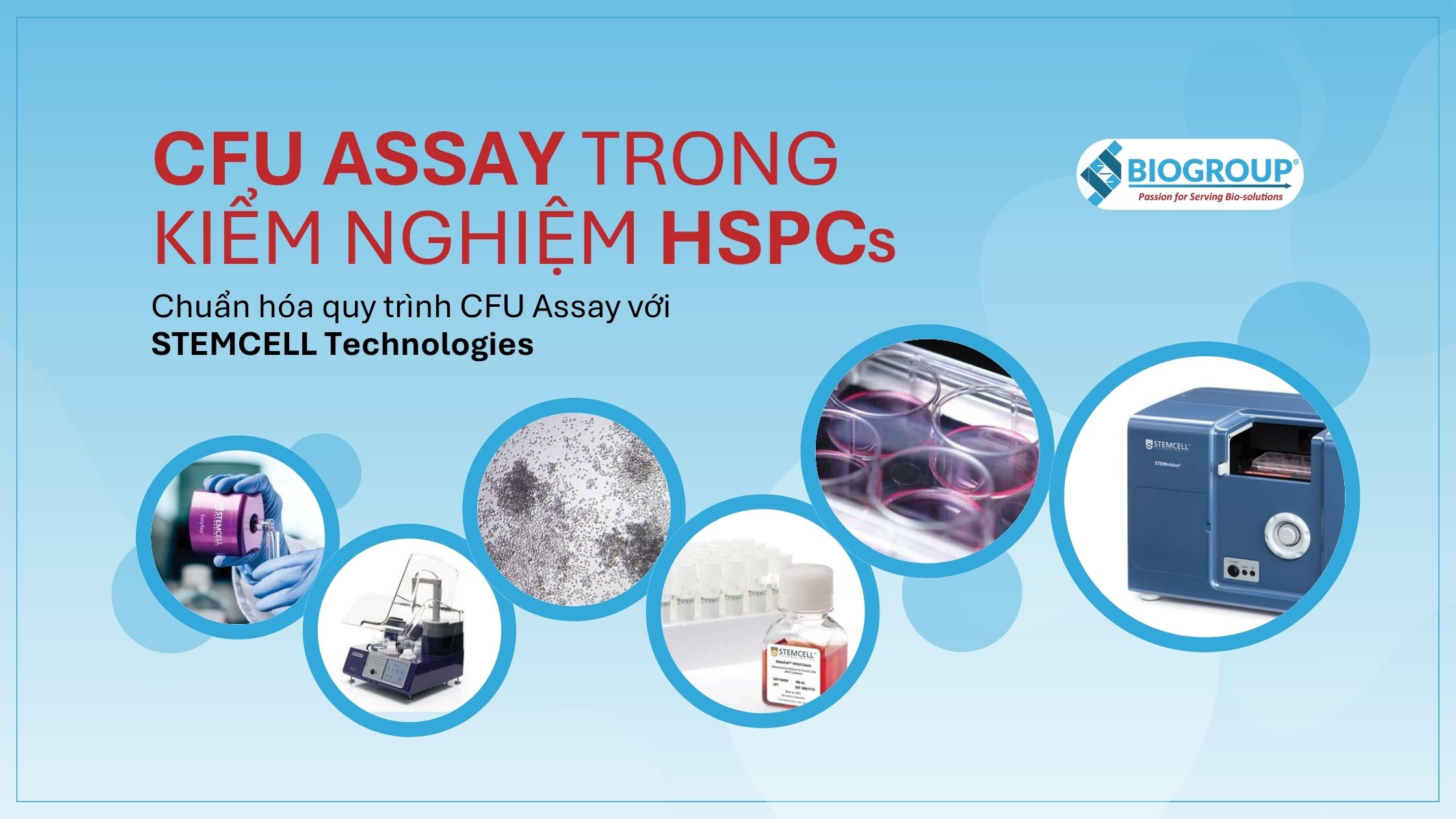Why is the CFU assay important in testing HSPCs before transplantation?
The CFU (Colony-Forming Units) assay ensures the quality of hematopoietic stem cells (HSCs) before transplantation. The CFU assay is used as a standard to assess the potency of HSCs by the FDA, FACT, and AABB.

Contents
ToggleOverview of Hematopoietic Stem Cells (HSCs) and the CFU assay
Stem cells are specialized cells that have the unique ability to self-renew, thereby generating a source of undifferentiated stem cells. They can also differentiate into specific types of cells, with specialized functions and full maturity. Therefore, stem cells are considered the “building blocks” of the tissues and organs where they reside.
Among the various types of stem cells, hematopoietic stem cells (HSCs) are the most extensively studied type of mature stem cell. They are considered a promising cell source for applications in both basic science and clinical medicine. Historically, research on HSCs began in the 1940s when a breakthrough experiment showed that intravenous bone marrow (BM) cells could prevent death in irradiated mice by restoring blood cell production. Since then, HSCs have been studied and applied in medical therapies and scientific research for decades..
Over time, more sophisticated tools have been developed to evaluate the behavior of pure hematopoietic cell populations capable of generating blood cells. One of the most reliable tools is the Colony-Forming Unit (CFU) assay. This method helps identify, count, and analyze clusters of cells formed from hematopoietic stem and progenitor cells (HSPCs) that have differentiated into myeloid, erythroid, and lymphoid lineages.
What are hematopoietic stem and progenitor cells (HSPCs)?
Hematopoietic stem and progenitor cells (HSPCs) comprise a heterogeneous population of stem cells and progenitor cells present in the body. Among these, hematopoietic progenitor cells (HPCs) are cells that have committed to differentiation and can differentiate into multi-potent, bi-potent, or uni-potent blood cells. Every year, the human body produces approximately 1.4 x 10¹⁴ new blood cells, including around 1.75 x 10¹¹ red blood cells, 7 x 10¹⁰ granulocytes, and 1.75 x 10¹¹ platelets. The balance of hematopoiesis ensures that the proper ratios of different progenitor cells are produced to meet the body’s needs when infected or injured.
Hematopoietic stem cells (HSCs) can self-renew and differentiate into different blood cell lineages. From these stem cells, the differentiation process splits into two main lineages: myeloid (myeloid progenitor cells) and lymphoid (lymphoid progenitor cells). The myeloid lineage produces various types of cells, such as eosinophils, basophils, neutrophils, monocytes, platelets, and erythrocytes. Meanwhile, the lymphoid lineage differentiates into crucial immune cells, such as T-cells and B-cells. This highlights the vital role of HSPCs in maintaining balance and development within the body’s hematopoietic system.
Characterization tests for hematopoietic stem and progenitor cells (HSPCs)
There are several types of assays for HSPC characterization, and the suitable test depends on the maturity of the cells being investigated. Generally, assays can be categorized as either phenotypic or functional assays.
Phenotypic assays
Phenotypic assays, such as flow cytometry, are used to investigate cell surface markers, like CD34, a phospho-glycoprotein first identified on HSPCs. However, it is also present in other cell types, such as those found in vascular tissue.
Functional assays
On the other hand, functional assays measure specific biological characteristics that indicate the cell’s function. These assays can be performed using in vivo or in vitro methods, each with its advantages and disadvantages.
The most effective method for assessing hematopoietic stem cell (HSC) function is the in vivo mouse engraftment assay, which builds upon the groundbreaking work of Till & McCulloch in the 1960s. However, this type of assay is often time-consuming, expensive, and difficult to evaluate. As a result, the CFU in vitro assay is recommended for assessing HSPC quality before transplantation, as it has been shown to correlate well with in vivo engraftment models.
- In vivo assays: Based on animal transplantation models, this method evaluates multi-lineage cell formation after more than 5 weeks.
- In vitro assays: Phương pháp CFU (Colony Forming Unit) được sử dụng để đánh giá sự phát triển của tế bào tiền thân (progenitor) và khả năng biệt hóa của chúng.
Why do experts choose the CFU assay?
Firstly, while other functional assays, like in vivo mouse engraftment or long-term culture-initiating cell (LTC-IC) assays, may be more suitable for assessing the function of primitive HSPCs, they are very complex and time-consuming, taking anywhere from 5 weeks to 6 months to complete. In contrast, the CFU assay takes only about 2 weeks, providing a significantly faster evaluation.
Moreover, the CFU assay has long been shown to have a strong correlation with successful engraftment in transplant recipients. A study by KM Page (2011) showed that the “CFU dose” is most closely related to the engraftment of neutrophils and platelets. This demonstrates that the CFU assay not only evaluates clustering potential but also accurately predicts transplant efficacy in clinical settings.
With its short duration and ability to accurately predict cell engraftment success, the CFU assay is the ideal choice for assessing the quality of HSPCs before transplantation. It is considered the gold standard for evaluating the potency of stem cell products because it correlates with successful engraftment rates and overall survival in HSC transplant recipients (Velier et al., 2019).
What are the regulations for the CFU assay?
Đối với các ngân hàng máu cuống rốn (Cord blood banks) ở Mỹ, tất cả đều phải được đăng ký với FDA. Hầu hết các ngân hàng này đều được chứng nhận bởi AABB hoặc FACT, và cả hai tổ chức này đều yêu cầu dữ liệu CFU trước khi đông lạnh (pre-freeze CFU data).
FDA compliance guidelines
The FDA requires stability testing and specifies CFU assays: “The stability testing program should include, but is not limited to, potency, integrity, and sterility of the product. Non-clinical laboratory data, such as in vitro CFU assays, may be used as part of the stability testing program, accompanied by clinical engraftment data if available.” (FDA-2006-D-0157)
FACT-JACIE standards (8th Edition)
FACT requires an annual evaluation program to assess the survival rates and potency of cryopreserved cell therapy products. (D9.2.3)
The evaluation must represent all processing methods and the maximum sample storage duration. (D9.2.3.1)
AABB standards (11th Edition)
The stability evaluation program must include: product container integrity, viable cell recovery, and potency evaluation of related cells. (5.20.2.1). The relevant potency assay must be defined by the performing facility. (5.17C, 5a).
NetCord-FACT banking standards (8th Edition – DRAFT)
Evidence of potency must be provided through a CFU assay or other validated potency tests on fresh samples obtained immediately after processing. Additionally, on representative samples before release to clinical programs. (D9, appendix V). [1]
This highlights the importance of CFU assays in ensuring the quality and potency of umbilical cord blood products before use for clinical transplantation purposes.
Standardizing the CFU assay process with STEMCELL Technologies
To control variability in CFU assays, standardized and long-term stable reagents should be used. This ensures the consistency and reliability of the assay. A prime example is the MethoCult medium, provided by STEMCELL Technologies for over 30 years, which ensures stability and quality for CFU assays. Additionally, standardizing the procedural workflow is crucial by implementing Standard Operating Procedures (SOPs) and ensuring proper training for staff to maintain consistency in technique and analysis. To support this, STEMCELL Technologies offers educational materials and proficiency testing programs to enhance expertise and knowledge. Moreover, the identification and counting of colony clusters – a highly subjective step in the CFU assay – should be standardized through rigorous training for manual operators to ensure accuracy and consistency. However, automation is recommended to minimize operator variability, enhance consistency, and expedite data analysis. These measures help reduce variability in the CFU assay, thereby increasing the accuracy and reliability of the analysis results.
Biogroup Vietnam, with our team of experienced experts and support from STEMCELL Technologies, is ready to assist you in standardizing the CFU Assay process to meet international standards.
Contact Biogroup Vietnam’s consulting experts:
- Website: https://biogroupvietnam.com/public/
- Hotline: +84 963 621 421
- Email: info@biogroupvietnam.vn
>> Learn more about CFU Assay products
>> Discover more STEMCELL Technologies products
References
1. STEMCELL Technologies. (n.d.). Homepage. https://www.stemcell.com/
2. Wong, C. (2023, August 31). What to know about hematopoietic stem cells. Medical News Today. https://www.medicalnewstoday.com/articles/285666
3. STEMCELL Technologies. (n.d.). Hematopoietic stem and progenitor cells [Brochure]. https://cdn.stemcell.com/media/files/brochure/BR29054-Hematopoeitic_Stem_and_Progenitor_Cells.pdf
Categories
- Blog (53)
- New Products & Technologies (42)
- News (41)
- Recruitment (7)
- Training & Webinar (27)
- Virtual Booth (1)




